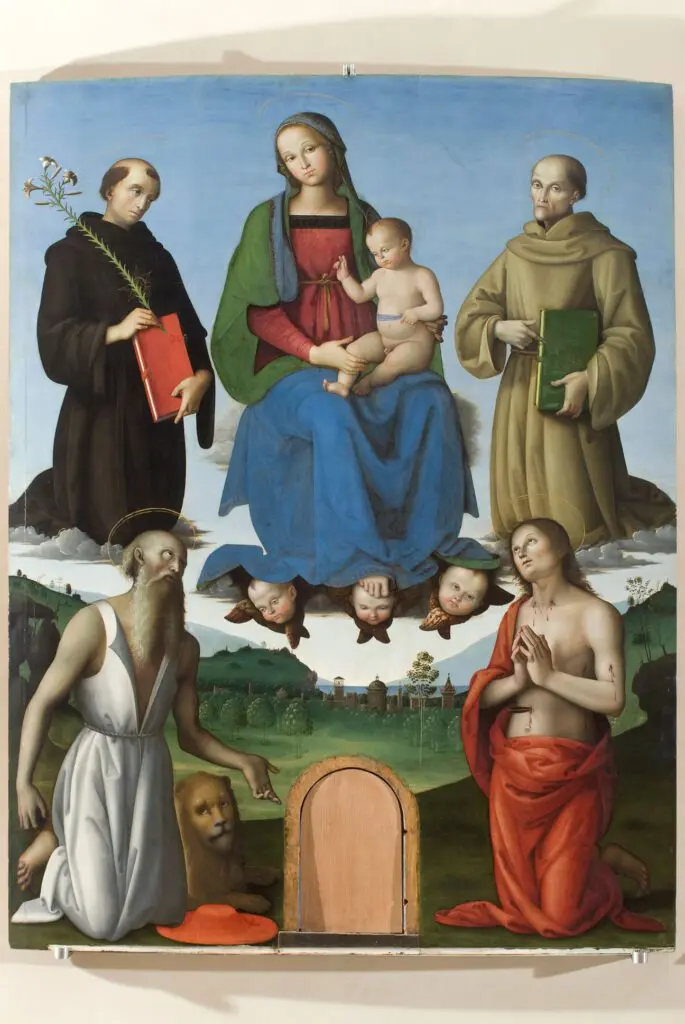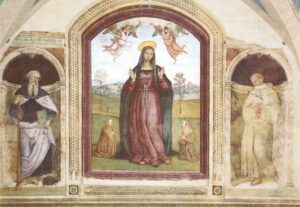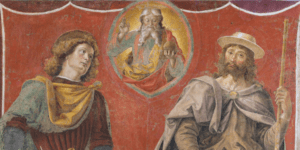From Perugino’s works in the National Gallery of Umbria
The Tezi Altarpiece was painted by Perugino in the heyday of his career. It shows a so-called sacra conversazione (from Latin conversari, to live with, or to have a meeting), basically Virgin Mary enthroned, surrounded by Saints.
The painting’s restoration brought back to light its precious colors and high technical quality. Such features lead us to think that the altarpiece was made by Perugino himself rather than by his coworkers on the basis of a preexisting pattern, as was often the case.

The structure
Virgin Mary floats in mid-air, supported by angels; the Infant Jesus is seated on her legs. On the right, Saint Bernardine of Siena is depicted, holding a book in his hand on which the JHS symbol appears. It means Jesus Hominum Salvator, “Jesus, the Savior of Humankind.” On the left, Saint Nicholas of Tolentino kneels, holding a lily in his hand. In the lower part of the painting there are two personages in an attitude of prayer: Saint Jerome, clad as a penitent, and Saint Sebastian, whose belly is transfixed by an arrow, and wearing a red cloak that symbolizes the blood of his martyrdom.
For Mary’s figure Perugino reuses a drawing he had already employed in his Madonna della Consolazione (Our Lady of Consolation); the four Saints are set symmetrically around her. Really poetical is the landscape in the background, where a town with many towers appears between green hills and the shores of a lake.
The work’s client, and its original aspect
The client of the Tezi Altarpiece was in fact Bernardino di ( = the son of) Angelo Tezi, a notary in the Colleges of both Money Changers and Priors in Perugia. He had the painting made for the altar of his family chapel dedicated to Saint Nicholas of Tolentino inside the Church of Saint Augustine in Perugia.
The altarpiece originally included a predella, a rectangular plate positioned at its basis, that showed the Last Supper. On the left, on a fake chart, we can read the client’s name. On the right, the date: “1500” is indicated.
In that very year Pietro Vannucci had completed the frescoes in the hearing room of the College of Money Changers. It is therefore possible that Tezi, as a notary in the same corporation, had met the painter there, and commissioned him.
In the lower part of the altarpiece we can still notice the hole for the tabernacle. It was originally closed by a small painted door (now lost), on which, as far as we know, the Savior was depicted.
The Altarpiece’s vicissitudes
We know for certain that in 1710 the altarpiece still belonged to the Church of Saint Augustine in Perugia, where it was firstly positioned in the chapel of Santa Lucia Vecchia (Saint Lucy’s, the older one), then in Saint Thomas’. In the late 18th century, though, it was disassembled. It lost its works of carpentry, and the central piece was set upon the door of the sacristy. It would be removed in 1863 and transferred to the Pinacoteca – the then Art Gallery, currently the National Gallery of Umbria – namely when it had become a property of the State after the National Unification of Italy.
The central panel was exhibited inside the same frame that had already contained Perugino’s Pala dei Decemviri (Altarpiece of Decemvirs / the Ten Men). That altarpiece, which had been stolen during Napoleon’s invasion of Italy, was later on given the Vatican Museums, where it can be admired still nowadays. Its predella also, that had remained in its sacristy up until 1784, was maybe taken away by the French soldiers; anyway, it finally resurfaced in Frankfurt, Germany, in the Veit Collection. What we know for sure is that in 1883 it was bought by the State Museum in Berlin. There, however, it is ascribed to a different author: Gerino from Pistoia.









